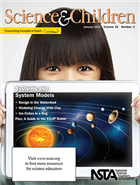System exploration in early childhood
By Peggy Ashbrook
Posted on 2015-01-14
 When winter sets in, teachers set aside time in the schedule for children to remove and store their winter outwear. Such a variety of clothing systems appear! Coats and jackets with zippers, hoods, snaps and Velcro, mittens and gloves, hats that pull on or strap on, snow pants and overalls, scarves and boots! These items are the parts of the system that keeps children warm outside.
When winter sets in, teachers set aside time in the schedule for children to remove and store their winter outwear. Such a variety of clothing systems appear! Coats and jackets with zippers, hoods, snaps and Velcro, mittens and gloves, hats that pull on or strap on, snow pants and overalls, scarves and boots! These items are the parts of the system that keeps children warm outside.
Children master the skill of putting on and fastening these items over time as their fine motor skills develop and they have repeated opportunities to practice. Some children get undressed or dressed faster than their classmates. Instead of waiting, they can collect data. On a tally chart with pictures of each kind of clothing, they can make a tally mark for each item they observe. Some questions to investigate include, “Does the number of _____ change with changing weather?” “What kind of hat do children find easiest to put on? What kind of jacket do children find easiest to fasten? Which kinds of fastening do children prefer?
 In the January 2015 issue of Science and Children, I wrote about children investigating coats as systems, examining the parts of various coats and measuring and recording data. What systems are the children in your program investigating?
In the January 2015 issue of Science and Children, I wrote about children investigating coats as systems, examining the parts of various coats and measuring and recording data. What systems are the children in your program investigating?
Although children experience a world where complex systems, such as atomic structure, operate, they may have not reached a developmental age where they understand these systems, forces and particles. We know this because researchers who investigate how children learn have discovered the age ranges when children can use their information to demonstrate or model these concepts (Michaels and others). Ready Set SCIENCE! (Michaels), particularly Chapter 3, discusses conceptual change in children’s thinking “as a result of instruction, experience, and maturation.” The authors state, “A key challenge for teachers is to build on students’ embodied knowledge and understanding of the world and to help them confront their misconceptions productively in order to develop new understanding” (pg 38).
Beginning with systems common in the lives of young children, early childhood educators can lay the foundation for later learning.
Michaels Sarah, and Andrew W. Shouse, Heidi A. Schweingruber. 2007. Ready, Set, Science!: Putting Research to Work in K-8 Science Classrooms. National Research Council
Disclaimer: The views expressed in this blog post are those of the author(s) and do not necessarily reflect the official position of the National Science Teaching Association (NSTA).


